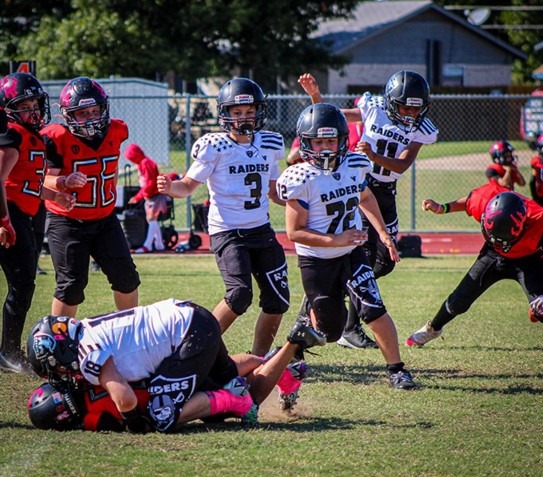
fall tackle football
Youth tackle football is a full-contact version of American football for young athletes, involving players from elementary school through middle school. Unlike flag football, it includes tackling, blocking, and a full range of physical contact. Players wear extensive protective gear, including helmets, shoulder pads, and mouthguards, to reduce the risk of injury.
How it's Played
Field and Players: Youth tackle football is often played on a regulation-size field (100 yards long) with two teams of 11 players each.
Physical Contact: The core difference from flag football is the use of tackling to stop the ball carrier. Players engage in physical contact to block, rush the passer, and bring down the opponent with the ball.
Rules: While the game follows the basic rules of high school or professional football (downs, scoring, penalties), many youth leagues have modified rules to enhance safety and promote skill development. These can include:
No kickoffs: To reduce high-speed collisions, the game may start and restart after a score with the ball placed at a specific yard line.
Limited blitzing: Some leagues restrict the number of blitzing defenders to protect the quarterback.
Modified tackling techniques: Modern coaching focuses on safer, rugby-style tackling techniques that emphasize using the shoulder and not the head to make contact.
Player Development: A major goal of youth tackle football is to prepare athletes for the demands of high school sports. This includes teaching proper form, advanced offensive and defensive schemes, and position-specific skills.
Benefits and Risks
Youth tackle football is a subject of ongoing debate, with discussions often centered on the balance between its benefits and the potential for injury.
Benefits
Physical Fitness: The sport is a demanding form of exercise that builds strength, endurance, and agility.
Teamwork and Discipline: Players learn to work together, rely on their teammates, and follow instructions from coaches.
Character Development: Many people believe the sport teaches resilience, leadership, and a strong work ethic, as players must persevere through physical and mental challenges.
Community: Youth football leagues can build a strong sense of community for players, coaches, and families.
Risks
Injury: The most significant concern in youth tackle football is the risk of injury, particularly head injuries. While equipment and coaching have improved, concussions and sub-concussive head impacts remain a concern.
Chronic Traumatic Encephalopathy (CTE): Research has linked repeated head impacts to a risk of developing CTE, a degenerative brain disease. This is a primary reason why some parents and experts are hesitant about youth participation.
Other Injuries: Beyond head injuries, players are also at risk for sprains, fractures, and other orthopedic injuries due to the physical nature of the game.
For many, youth tackle football remains a cherished tradition that teaches valuable life lessons. However, the increased awareness of the risks, especially concerning head injuries, has led to a greater emphasis on safety protocols, better coaching techniques, and a more informed decision-making process for parents.
*ffering opportunities for kids ages 7 to 12